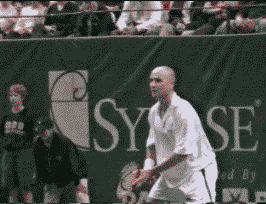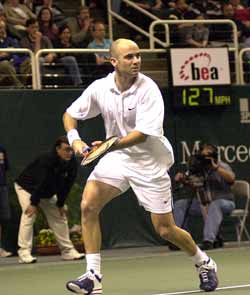<% ns_puts [mkm_getnavbar] %>

Advanced Tennis:
Myth of the Backswing
by John Yandell
Still photos by J. Gregory Swendsen
|
“Get your racquet back early!” It’s a universal mantra in club tennis and tennis teaching. Perhaps you believe in “early racquet preparation” and have labored hard to follow this sacred advice. If so, you are the victim of one of the most powerful myths in tennis: the myth of the backswing. The idea that the backswing is the key to good preparation is a myth that has caused great damage to players at all levels.
How can the backswing be a myth? All strokes have a preparation phase, and obviously, this must involve the racquet at some point. But the fact is good players don’t initiate their forehands by “taking the racquet back.”
The real key to early preparation is not the racquet, but the shoulders and feet. The first move is a full body turn, or a unit turn, initiated with the feet and the torso. There is no independent arm movement. The backswing is a secondary phase that follows this first move with the body.
What are the drawbacks of starting your forehand with a “backswing”?
|
If the arm moves independently at the start of the motion, the bio-mechanics of the entire stroke are thrown out of sequence. The shoulder turn will be incomplete. This means the shoulders cannot rotate fully back through the shot. Not only is the rotation of the shoulders more limited, it also tends to be premature, so that the shoulders and hips are too open at contact.
In addition to limiting the role of the shoulders, taking your racquet back first often creates another critical problem: poor hitting arm position. When the arm moves first, there is a high probability that the racquet will never find the correct position at the end of the backswing, when it actually starts forward to the ball.
Typically the racquet position as this point will be too high, and the hitting arm will be too straight. The contact will be late. The racquet head will tend to veer rapidly off the shot line and across the body. The forward swing, like the preparation, will come primarily from the arm, sometimes with tremendous muscle effort, but the player will be unable to tap his real potential to generate power or topspin. In extreme cases, the player may actually slice under the ball, losing the ability to hit with topspin. Control and fluidity are lost, and the arm and elbow take a beating.
If we look at virtually all the top players in the pro game -- and players with solid groundstrokes at any level -- we never see the hitting arm or racquet move first. The backswing is a secondary element to the critical first move with the feet and shoulders.
Watch Pete Sampras, Andre Agassi, Lindsay Davenport, even heavy topspin players, such as Tommy Haas. The first move is virtually identical. The feet and the shoulders turn sideways. The left or opposite hand stays on the racquet. <% ns_puts [nsv_get mkm_includes mkm_oldContentFooter_inc] %>


